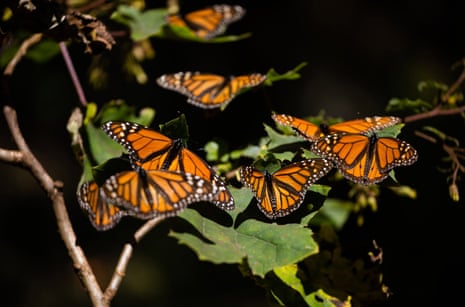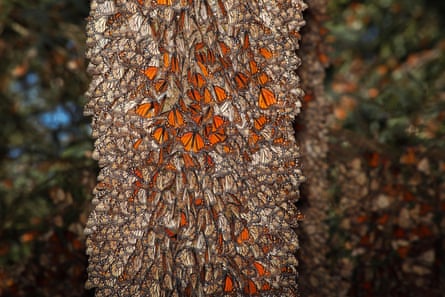Experts say the endangered insect numbers fell by 59% this year, blaming pesticide use and climate change for the reduction

Associated PressThu 8 Feb 2024
The number of endangered monarch butterflies at their wintering areas in Mexico has dropped by 59% this year to the second lowest level since record keeping began, experts said, blaming pesticide use and climate change.
The annual butterfly count doesn’t calculate the individual number of butterflies, but rather the number of hectares they cover when they clump together on tree branches in the mountain pine and fir forests west of Mexico City. Monarchs from east of the Rocky Mountains in the US and Canada overwinter there.
The butterflies’ migration from Canada and the US to Mexico and back again is considered a marvel of nature. No single butterfly lives to complete the entire journey.
Mexico’s Commission for National Protected Areas said on Wednesday the butterflies covered an area equivalent to 0.9 hectares (2.2 acres), down from 2.21 hectares (5.4 acres) last year.
The lowest level was in 2013 at 0.67 hectares.
“It has a lot to do with climate change,” said Gloria Tavera, the commission’s conservation director. She cited storms, drought and higher temperatures.
Experts noted there were almost no butterflies at some traditional wintering grounds.
“The monarchs looked for other sites,” Tavera said.

A tree full of monarch butterflies at the Rosario Sanctuary, Michoacan, Mexico in 2020.
Photograph: Brian Overcast/Alamy
The number of a smaller population, the western monarch butterflies that overwinter in California, has dropped, too.
In 2022, there was a reported increase, when experts said that 35% more monarch
butterflies arrived to spend the winter in mountaintop forests compared with the previous season of 2021.
Gregory Mitchell, a researcher for Environment and Climate Change Canada, called the decline “very sobering,” but noted that “we have the drive, we have the tools, we have the people” to address humans’ impact on the monarch migration.
Humberto Peña, the head of Mexico’s protected areas, proposed creating a “safe corridor” for migrating butterflies with reduced herbicide and pesticide use and stricter measures against deforestation.
The use of herbicides in the US and Canada has reduced the amount of milkweed, the butterflies’ preferred food.
But there was some good news. Deforestation in the Mexican forests where monarch butterflies spend the winter fell this year to about 4.1 hectares. Almost all was lost to illegal logging.
That was a large reduction from last year, when 58.7 hectares of forest cover was lost.
Illegal logging has been a major threat to the forests where the butterflies gather in clumps to keep warm. Diseases, drought and storms have also caused tree losses.
The number of a smaller population, the western monarch butterflies that overwinter in California, has dropped, too.
In 2022, there was a reported increase, when experts said that 35% more monarch
butterflies arrived to spend the winter in mountaintop forests compared with the previous season of 2021.
Gregory Mitchell, a researcher for Environment and Climate Change Canada, called the decline “very sobering,” but noted that “we have the drive, we have the tools, we have the people” to address humans’ impact on the monarch migration.
Humberto Peña, the head of Mexico’s protected areas, proposed creating a “safe corridor” for migrating butterflies with reduced herbicide and pesticide use and stricter measures against deforestation.
The use of herbicides in the US and Canada has reduced the amount of milkweed, the butterflies’ preferred food.
But there was some good news. Deforestation in the Mexican forests where monarch butterflies spend the winter fell this year to about 4.1 hectares. Almost all was lost to illegal logging.
That was a large reduction from last year, when 58.7 hectares of forest cover was lost.
Illegal logging has been a major threat to the forests where the butterflies gather in clumps to keep warm. Diseases, drought and storms have also caused tree losses.
No comments:
Post a Comment